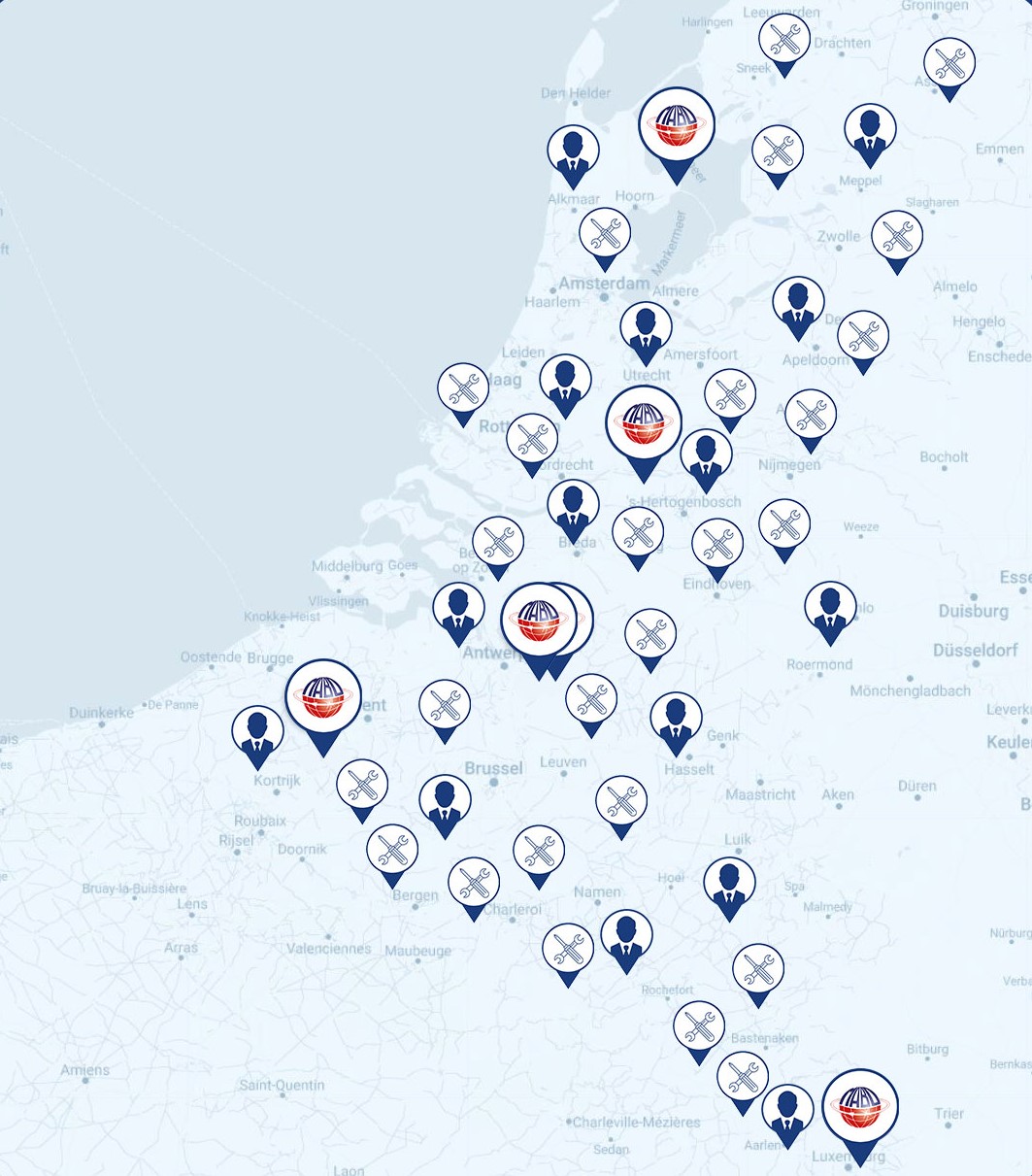Nieuwe productiehal en Combilift Straddle Carrier bereidt Spaansen Bouwsystemen voor op verdere groei.
Spaansen Bouwsystemen barst van ambitie. In drie jaar tijd verdubbelde het familiebedrijf in Harlingen haar productie van betonnen prefab elementen voor de woningbouw. Om korte doorlooptijden te blijven garanderen werd onlangs een nieuwe 4.000 m² productiehal in bedrijf genomen en ruilde Spaansen de oude bokkenwagen in voor een Combi-SC. “De interne handling van onze A-frames met wanden is qua comfort, nauwkeurigheid en snelheid met 50% toegenomen. We zijn klaar voor de toekomst.” aldus Ferdinand Metzlar, Directeur Operations.
Professionele afstemming: hét verschil voor aannemers
Spaansen Bouwsystemen is een divisie van Spaansen Groep B.V. in Winkel, Noord Holland. Rond het millennium verlegde Arie Spaansen de focus van systeemvloeren naar wanden. “Een vloer op zijn kant is een wand.” redeneerde hij. Inmiddels is Spaansen Bouwsystemen een waardevolle partner voor middelgrote en grote aannemers gespecialiseerd in betonnen prefab woningen en appartementen. “De flexibiliteit in ontwerp en uitvoering van onze elementen, en optimale afstemming tijdens het bouwproces besparen aannemers tijde, kosten en kopzorgen.” geeft Metzlar aan.
Dat aannemers de toegevoegde waarde van Spaansen erkennen blijkt wel uit de verdubbeling in productie, die overigens wel voor de nodige druk zorgde in het logistieke proces. Robert Kootstra, Hoofd Technische Dienst: “Het opslaan en handlen van betonnen casco elementen is een kunst op zich. De grootste elementen zijn ruim 4 meter hoog en wegen zo’n 4 tot 6 ton. Ze mogen enkel verticaal en op een voldoende harde ondergrond geplaatst worden, zonder risico op omvallen. Onze oude bokkenwagen was niet snel en wendbaar genoeg om de toegenomen aantallen casco’s te verwerken. We zocht een sneller, slimmer heftoestel dat in te toekomst zou blijven voldoen, en dachten direct aan de Straddle Carrier die we een beurs in Duitsland hadden gezien.”
De Combilift Straddle Carrier: oppakken en wegwezen
Volgens Ard van de Maten van Mabo BeNeLux Nederland, exclusieve importeur van de Combilift Straddle Carrier, is de mobiele containerlift/portaalkraan een kostenbesparende en flexibele oplossing voor bedrijven die actief zijn in distributie, transport en opslag van volumineuze goederen.
“Dankzij zijn eenvoudige design en modulaire bouw kan hij volledig gebouwd worden volgens de wensen van de klant, die kan kiezen uit hefcapaciteiten tussen 20 en 80 ton. Revolutionair is zijn driewiel concept waardoor hij uiterst wendbaar is en een draaicirkel heeft die helft kleiner is dan gelijkaardige concepten. Bovendien behoudt de transporteerbare Straddle Carrier veel meer zijn restwaarde, in tegenstelling tot bijvoorbeeld een statische kraan op locatie.”
Stepping up to the plate with Combilift: Twice as fast and doubled storage space with a Combi-SC.
Lifting and moving 35t loads of steel plate efficiently and safely is a tough job, and one that Rico Honselaar, Operations Manager of De Boer Staal knows only too well. Having looked at various methods for handling these extreme loads at the company’s site at Uitgeest, to the northwest of Amsterdam, De Boer Staal found the solution in the form of a 35t capacity Straddle Carrier from the Irish specialist manufacturer Combilift, which they say is “ideal, flexible and cost effective.”
De Boer Staal is wholesale distributor and has large stocks of sheet steel, profiles and bulb flats in all standard sizes, grades and thicknesses, mainly for the shipbuilding industry. It also operates an in-house coating line together with steel cutting from its affiliated company De Boer Snijbedrijf. It is therefore able” to offer a flexible and comprehensive service in complete shipbuilding kits and fast completion of projects for its customers.
In spite of the wide range of equipment on the market, none of these were a match for De Boer Staal’s requirements for a versatile system for offloading stacks of plates from incoming trailers, stacking them in the yard, moving them around the premises, inside and out and reloading for dispatch. Any heavy duty forklifts powerful enough to lift 35t are extremely large, very expensive and have a high unloaded weight. They are also not the safest machines for handling plates which can be up to 12m long and over 3m wide and their size hampers any attempts to move the loads into the cutting and painting areas. Further options of overhead cranes or gantries were discounted as these are fices and therefore limited to use in one specific area.
Customised build
“We initially found out about the Combi-SC on the internet and contacted the distributor for the Netherlands, Mabo BeNeLux Nederland, for further information.” says Rico. “Together with Mabo BeNeLux’s Kristiaan Feldkamp we visited a concrete company that was using a Combi-SC and it was immediately 100% obvious that it would ensure the stable handling of our products too. We worked with Kristiaan and the manufacturers to come up with a highly customised specification which included features such as a hydraulic spreader with clamps which independently clamp the front and rear of the load when it is lifted. The dimensions were also tailor made for us – the machine is 1.3m wider in the load area than standard, at 4.3m, and the height is 4.25m compared to the standard 4.95m to accommodate the size of the plates and to enable the machine to go inside without needing a telescopic facility. The light own weight of the Combi-SC is also an advantage as we do not have to worry about extra ground reinforcement.”
Manoeuvrable and nifty
The Combi-SC range was initially developed for economical container handling but it quickly became apparent that it would be of major benefit in other industry sectors which handle extreme or oversized loads, and De Boer Staal is a prime example. The machine’s small turning circle and manoeuvrability enable it to go anywhere on site and space utilisation has been optimised. Rico reckons that 50% more stock can now be accomodated on site as plates can be stored closely together with just a couple of metres width between each stack – this would have been impossible with a heavy duty forklift which needs large areas for manoeuvering. At busy times the Combi-SC is on the go for 10 hours a day, moving 10,000t of plates and in just three months of the operation since it was delivered it has already clocked up 255 hours. It is no surprise therefore that significant time savings have also been achieved when it comes to loading and unloading trailers: the Combi-SC can be unload ten loads from one trailer a day compared with five using a crane.
Remote control
De Boer Staal’s machine is the first LPG powered Combi-SC to be operational in the Netherlands. According to Kristiaan the LPG powered engine has enabled substantial cost savings over a very expensive Tier 4 diesel engine that would accord to the directives for indoor operation. De Boer Staal also chose a remote control model for a number of reasons: the relatively compact size of the premises makes it suitable for pedestrian operation for a start, and it can be operated by one employee without the need for a banksman. All round visibilty of the working environment together with a lack of manual handling, guarantees a high level of safety for all personnel involved. The three operators also found the theoretical an practical training by Mabo BeNeLux’s field engineers easy and quick.
A strong solution
“Both Mabo BeNeLux and Combilift understood what we needed”, says Rico. “With our Combi-SC, which our employees have named ‘Ted’ adter the famous Dutch Strongman Ted van de Parre, we have found the best solution to our problem. It gives us the independence to offload and move our loads whenever and to wherever we want and we have maximised our space utilisation so we can order in volume and stock larger quantities of plate than before. Ted was affordable and will pay itself in short space of time.”





